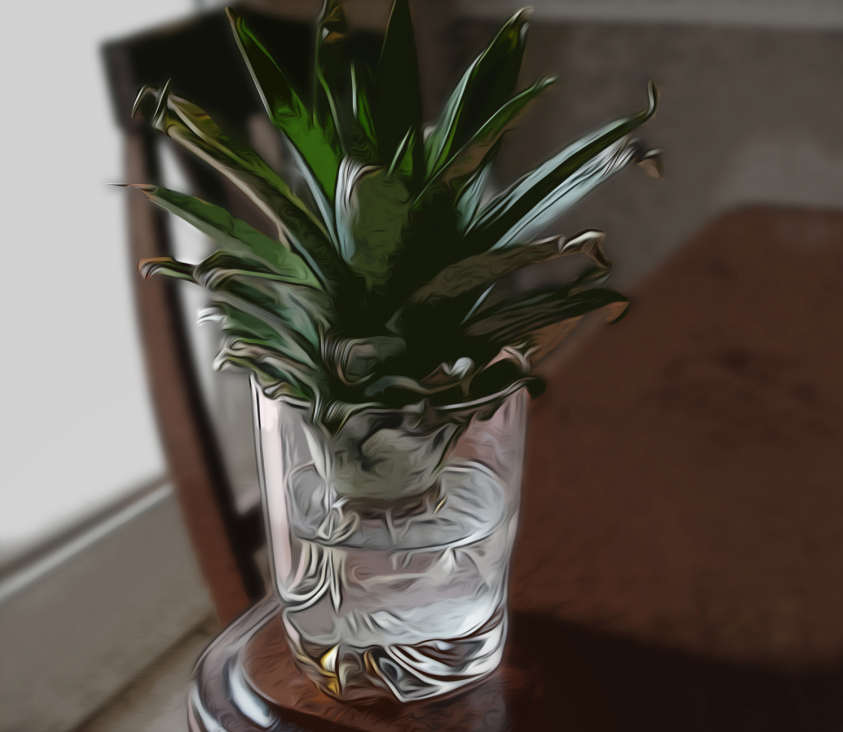With seedlings and seeds in short or inconsistent supply and the spring growing season quickly passing us by, starting a garden can feel daunting. But did you know that there are many plants you can grow from kitchen scraps and cuttings?
You can start the following kitchen scraps with a little water in a shallow bowl or cup. Simply place them bottom side down in the water, and they will start to grow roots and a little more green material. Once you get a little growth, you can transplant these into pots.
– Lettuce
– Cabbage/Bok Choy
– Celery
– Green onions
– Garlic
– A sprig or cutting from nearly any stem style herb
Growing from Scraps: Vegetable Pieces
Alliums
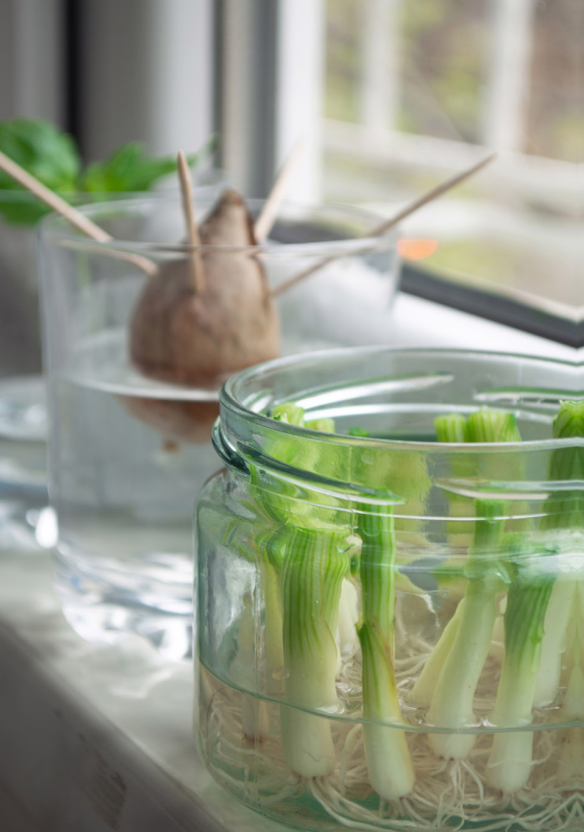
If you can grow these in a large container or garden bed, let some go to seed and either keep the seeds or break them back up into the bed or pot. Then you’ll have them come back up on their own in the next growing season. Onions, green onion, and garlic are great candidates for this sort of ‘permanent’ crop growing.
Certain root crops can be regrown but may need a little extra attention—onions, for instance.
If you’ve ever seen an onion start sprouting on its own in the pantry, you’ll notice two or three stems are coming from the center of the bulb. You can’t simply replant the onion in the ground unless your only goal is to collect seeds from it. But if you’ll gently peel away the layers of the onion, near the center, you will see those green bits connect to smaller pieces of onion inside. You should have one thin little onion piece connected to each green stalk. So you gently remove those and plant them in some good soil, and each will become an entire onion.
So you can eat the layers you peeled off the original onion, then plant the two little bulbs you found inside. And when they are grown, you can eat one and let the other go to seed so you can grow a ton more onions!
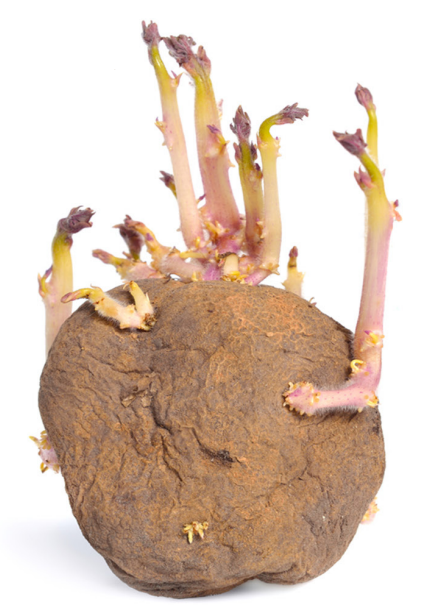 Potatoes
Potatoes
Potatoes can be grown in a couple of different ways. Once your potatoes in the pantry start to grow eyes, you can cut off a chunk of potato around the eye and let it dry on the counter for a day. (This helps prevent rotting.) Then you simply plant it eye up, a few inches deep in the soil. Potatoes are notoriously easy to grow and should take off quickly.
The way I prefer to plant potatoes is to just bury the entire potato. Place the best-looking one eye up and put the potato about 6-8 inches underground. Use loose well-draining soil, and you should see green coming up in a week to 10 days.
Sweet Potatoes
Sweet potatoes, which are not a potato at all, grow a little differently. You have to grow “slips” from an existing sweet potato and then plant those.
So grab a medium-sized sweet potato tuber and stick some toothpicks to suspend it over a glass of water. You will want to change out the water about every other day. The tuber also needs to be right side up. There is a pointy end and a flatter end; the pointy end goes upwards. You’ll want the water to be halfway up the tuber.
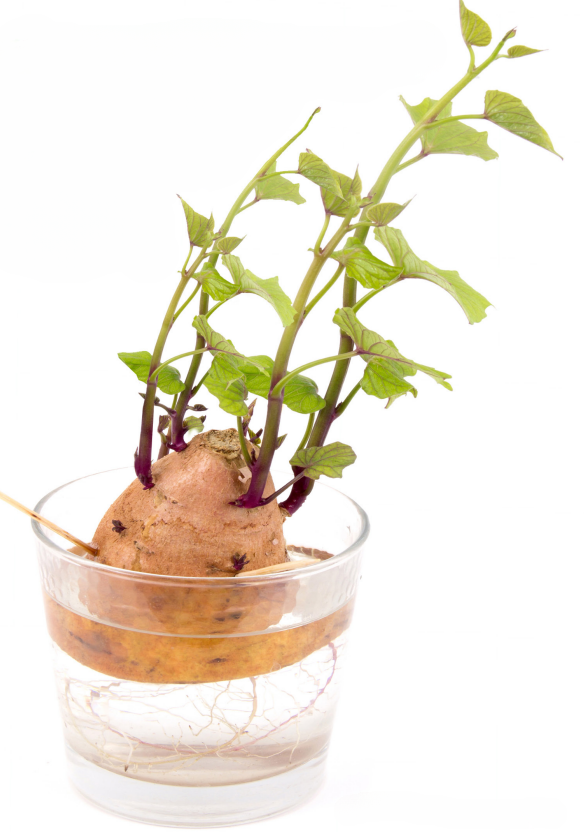
Give it a couple of weeks, and roots will start to grow from the bottom of the tuber, and leafy sprouts will begin to grow from the top. Once those sprouts are about six inches long, you can twist them off the tuber at the base and put them in another glass of water, so the bottom two inches are covered. These sprouts are called “slips.”
Once the slips have two or three inches of roots coming from them, you can plant them in some good loose, well-fertilized soil. They will create a lot of long vines and be ready to harvest at the end of the year. The young shoots, as well as the tubers, are edible.
Pineapple
Pineapple can also be grown from scraps! Simply cut the top off the pineapple and remove as much fruit as possible from the green leafy bits. Then place the top into a glass of water. Once a root system starts to develop, you can plant it in a container or the ground. They like a good amount of sun and should produce a pineapple for you the following year.
A good idea would be to start a raised pineapple bed and stick all your tops from the year in it, then next year, do the same with the tops of the new fruit. Before you know it, you’ll be overrun with pineapple plants!
Tops for Seeds
Some veggies can be regrown by planting the tops, but they won’t actually regrow an edible part: things like carrots, radishes, and beets. But they are worth planting because the tops will continue growing and will go to seed. Just think—4 or 5 carrot tops could give you enough seed to grow 50 pounds of carrots the following year, or depending on your growing zone, even this year. Even at current market prices, that’s a ton of value from something you’d have thrown away.
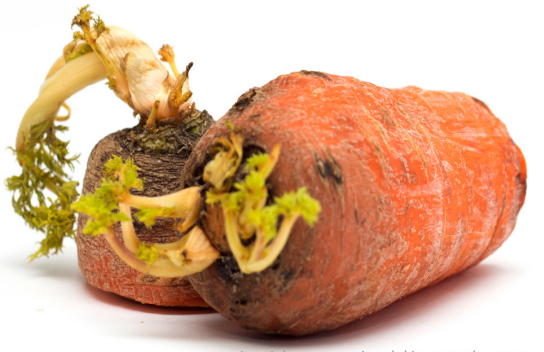
Growing from Scraps: Seeds
Now that we are getting down to the seeds discussion of this article, so many veggies we buy have seeds. It is nearly impossible to tell if you’ve gotten something that’s an heirloom or something that’s hybrid. And the best advice I can give you is to pick up a few organic veggies for seed harvesting. It’ll give you the best shot for getting an heirloom seed.
Now that’s not to say all hybrid seeds are bad. It doesn’t always mean it won’t produce right, it just means it might not produce right. You may plant a bell pepper and get 10 peppers off of it, but they are all bent sideways and a funny color. Or you might get one beautiful pepper, and that’s it. Either way, you can still eat them!
Possible Extra Steps
Most seeds from veggies can be directly planted and grown unless they have a glob of gel-like material around them, for example, tomatoes. That material surrounding the seed is a natural growth inhibitor. It actually prevents the seeds from sprouting while still inside the tomato. You can soak the seeds in some water for a few days to let that gel ferment off, or just directly plant slices of tomato in the ground where the fermentation process will happen naturally.
Growing from Scraps: Fruits
As far as using fruit to regrow from scraps and seeds, it’s largely not a good idea. Many fruit trees are grafted to make them strong. And a seed will take a very long time to mature, and the tree very well may die from disease. Some things you can often grow, though, are berries, passion fruit, pomegranate, dragon fruits, kiwi, and grapes. Anything that is vining or shrub-like has a good chance of growing from a fruit seed.
There are so many possibilities available to you in just a pile of kitchen scraps from an evening’s dinner. All you need is a little knowledge to grow a table full of food from a handful of garbage!
This article was originally written by Adrian Willis and published in Survival Dispatch Insider magazine Volume 4 Issue 7.
=====
Become a Survival Dispatch Insider …
We bring together survival enthusiasts and preppers to share skills and knowledge, so you can enhance your preparedness for emergencies and ensure the safety of you and your community.
The Results You’ll Get …
Our community, courses, and memberships are pretty special. We focus on the ways it will make a huge difference in your life.
Here are a few of the things you’ll be able to do as a member of Survival Dispatch Insider …
1) Improve your emergency preparedness by learning survival skills and strategies from experienced preppers.
2) Build lasting connections with like-minded individuals that share your passion for safety and readiness.
3) Access a wealth of knowledge and resources to assist in protecting you and your community during unexpected situations.
Click HERE to get started.
=====

